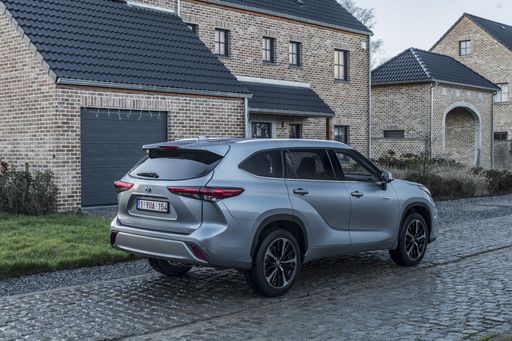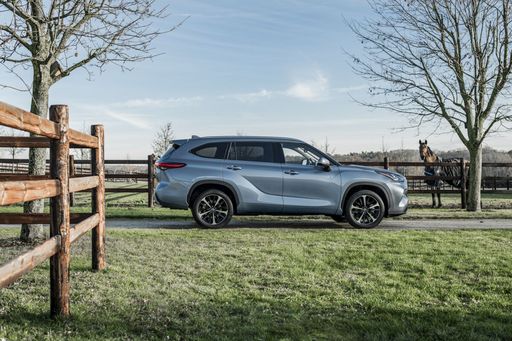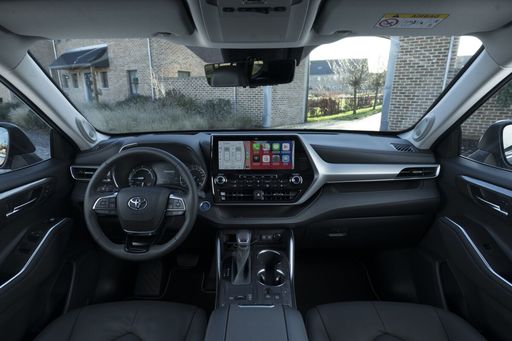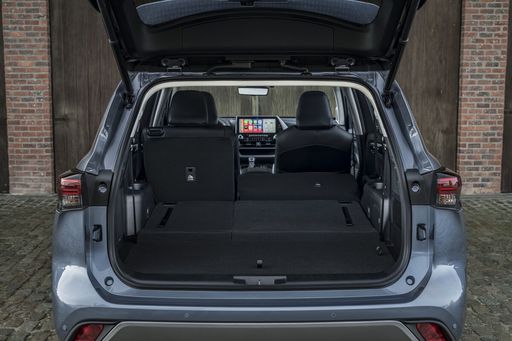Mercedes Sprinter Bus vs Toyota Highlander – Differences & prices compared
Compare performance, boot space, consumption and price in one view.
Find out now: which car is the better choice for you – Mercedes Sprinter Bus or Toyota Highlander?
The Mercedes Sprinter Bus (Bus) comes with a Diesel engine and Manuel or Automatic transmission. In comparison, the Toyota Highlander () features a engine with transmission.
When it comes to boot capacity, the Mercedes Sprinter Bus offers , while the Toyota Highlander provides – depending on how much space you need. If you’re looking for more power, decide whether the 190 HP of the Mercedes Sprinter Bus or the of the Toyota Highlander suits your needs better.
In terms of consumption, the values are 9.30 L per 100 km for the Mercedes Sprinter Bus, and for the Toyota Highlander.
Price-wise, the Mercedes Sprinter Bus starts at 41400 £, while the Toyota Highlander is available from . Compare all the details and find out which model fits your lifestyle best!
Mercedes Sprinter Bus
The Mercedes-Benz Sprinter Bus stands out as a versatile option for those seeking both comfort and practicality in a people mover. Its spacious interior design ensures ample room for passengers while maintaining a smooth and efficient driving experience. With its advanced safety features and modern amenities, the Sprinter Bus continues to be a leader in its class.
detailsToyota Highlander
The Toyota Highlander is a versatile SUV that seamlessly blends comfort and practicality, making it an ideal choice for families and adventurers alike. With its spacious interior and a clever layout, it offers ample room for passengers and luggage, ensuring every journey is a comfortable experience. Its sophisticated design is complemented by advanced technology features, enhancing both connectivity and safety on the road.
details @ Toyota
@ Toyota
 @ Toyota
@ Toyota
 @ Toyota
@ Toyota
 @ Toyota
@ Toyota
 @ Toyota
@ Toyota

|
|
|
|
|
Costs and Consumption |
|
|---|---|
|
Price
41400 - 55900 £
|
Price
-
|
|
Consumption L/100km
9.3 - 12.3 L
|
Consumption L/100km
-
|
|
Consumption kWh/100km
-
|
Consumption kWh/100km
-
|
|
Electric Range
-
|
Electric Range
-
|
|
Battery Capacity
-
|
Battery Capacity
-
|
|
co2
244 - 322 g/km
|
co2
-
|
|
Fuel tank capacity
71 L
|
Fuel tank capacity
-
|
Dimensions and Body |
|
|---|---|
|
Body Type
Bus
|
Body Type
-
|
|
Seats
2
|
Seats
-
|
|
Doors
4
|
Doors
-
|
|
Curb weight
2356 - 2559 kg
|
Curb weight
-
|
|
Trunk capacity
-
|
Trunk capacity
-
|
|
Length
5932 - 6967 mm
|
Length
-
|
|
Width
1993 mm
|
Width
-
|
|
Height
2633 - 2659 mm
|
Height
-
|
|
Payload
814 - 1144 kg
|
Payload
-
|
Engine and Performance |
|
|---|---|
|
Engine Type
Diesel
|
Engine Type
-
|
|
Transmission
Manuel, Automatic
|
Transmission
-
|
|
Transmission Detail
Manual Gearbox, Automatic Gearbox
|
Transmission Detail
-
|
|
Drive Type
Rear-Wheel Drive, All-Wheel Drive
|
Drive Type
-
|
|
Power HP
114 - 190 HP
|
Power HP
-
|
|
Acceleration 0-100km/h
-
|
Acceleration 0-100km/h
-
|
|
Max Speed
150 - 159 km/h
|
Max Speed
-
|
|
Torque
300 - 450 Nm
|
Torque
-
|
|
Number of Cylinders
4
|
Number of Cylinders
-
|
|
Power kW
84 - 140 kW
|
Power kW
-
|
|
Engine capacity
1950 cm3
|
Engine capacity
-
|
General |
|
|---|---|
|
Model Year
2024 - 2025
|
Model Year
-
|
|
CO2 Efficiency Class
G
|
CO2 Efficiency Class
-
|
|
Brand
Mercedes-Benz
|
Brand
-
|
Mercedes Sprinter Bus
The Mercedes-Benz Sprinter Bus: A Revolution in Transport
The Mercedes-Benz Sprinter Bus has long been a symbol of efficiency and reliability. Renowned for its versatility and performance, Mercedes-Benz continues to push boundaries with its latest models, catering to the needs of businesses and individuals alike. Whether used for passenger transport or as a corporate shuttle, the Sprinter Bus offers an exceptional driving experience, combining innovative technology with superior comfort.
Engineering Excellence: Under the Bonnet
At the heart of the Mercedes-Benz Sprinter Bus is its robust engine lineup, offering power outputs ranging from 114 PS to an impressive 190 PS. These variants ensure that there is a model suitable for every requirement, whether you need efficient city commuting or robust highway cruising.
The Sprinter Bus is equipped with either a manual or automatic transmission, providing flexibility to suit different driving preferences. The sophisticated 9G-TRONIC automatic gearbox represents a pinnacle of automotive engineering, ensuring smooth and efficient gear changes, which enhance the overall driving experience.
Performance and Efficiency: Meeting Environmental Standards
The Sprinter Bus's diesel engines are not just about power; they also focus on fuel efficiency, with consumption figures between 9.3 L/100km and 12.3 L/100km. The inclusion of start/stop technology helps in reducing fuel consumption, thus making it more economical and environmentally friendly.
Mercedes-Benz shows its commitment to sustainability by ensuring all engine options comply with stringent emissions standards. The models provide a CO2 efficiency class of G, underlining the brand's dedication to creating vehicles that are as kind to the planet as they are to your pocket.
Design and Comfort: Where Function Meets Style
The design of the Mercedes-Benz Sprinter Bus effortlessly combines functionality with aesthetics. The interior space is crafted to provide maximum comfort for passengers, while the exterior design leaves a lasting impression with its sleek lines and authoritative presence.
The Sprinter Bus can accommodate up to nine seats, making it ideal for passenger transport. Options such as air conditioning, advanced infotainment systems, and ergonomic seating ensure a pleasant experience for both driver and passengers, even on long journeys.
Safety and Technology: Prioritising Your Well-being
The Sprinter Bus offers a suite of advanced safety features aimed at keeping occupants safe, including adaptive cruise control, lane keep assist, and crosswind assist. These features are integrated with cutting-edge technology, such as the Mercedes-Benz User Experience (MBUX) system, which enhances connectivity and user interaction.
With rear-wheel drive and optional all-wheel drive capabilities, the Sprinter Bus is equipped to handle a variety of terrains and weather conditions, providing reassurance for every journey.
The Future of Transport: Innovative Options
Mercedes-Benz demonstrates their innovative edge with customisation options tailored to various business needs, be it for luxury transport or robust utility. Additionally, the Sprinter Bus's load capacity ranges from 814 kg to 1,249 kg, ensuring businesses can meet their logistical needs efficiently.
As demands for sustainable transport solutions grow, the Sprinter Bus is positioned as a forward-looking vehicle that blends traditional Mercedes-Benz quality with modern innovations.
The Mercedes-Benz Sprinter Bus is more than just a vehicle; it is an investment in exceptional performance and unmatched adaptability, engineered to meet the diverse demands of today's transport sector. From its powerful yet efficient engines to its state-of-the-art technology and safety features, the Sprinter remains a leader in its class.
Toyota Highlander
Meet the Toyota Highlander: A Synergy of Power and Efficiency
The Toyota Highlander stands as a testament to modern automotive engineering, blending robust design with state-of-the-art hybrid technology. Designed for families seeking both luxury and practicality, this SUV is more than just a means of transportation—it is an innovative solution to contemporary demands.
Stellar Performance and Hybrid Technology
Under the bonnet of the Highlander lies a full-hybrid powertrain that marries efficiency with performance. Producing an impressive 248 PS, the Highlander doesn't just promise power but delivers it with a refined acceleration from 0 to 100 km/h in just 8.3 seconds. Such performance is coupled with a frugal fuel consumption rate ranging between 6.6 and 7.1 L/100km, setting a benchmark for hybrid SUVs in its class.
A Dynamic Driving Experience
Fitted with a Continuously Variable Transmission (CVT), the Highlander ensures a smooth and responsive driving experience. The all-wheel-drive system enhances safety and control, providing confidence across various driving conditions. With a maximum speed of 180 km/h, this SUV is crafted to perform on both city streets and open highways.
Precision Engineering and Eco-Conscious Design
The Highlander boasts a four-cylinder engine with a displacement of 2487 cm³, perfectly balancing power and environmental considerations. Despite its robust performance, the vehicle remains eco-conscious, adhering to CO2 emissions ranging from 149 to 160 g/km, classified under the CO2 efficiency classes E and F.
Space and Luxury Redefined
Designed with practicality in mind, the Highlander seats seven comfortably, making it an ideal choice for family adventures. Its 241-litre boot capacity, expandable with rear seats folded, ensures storage space is never a concern. From its elegant body design measuring 4966 mm in length to its expansive width of 1930 mm, the Highlander exudes both strength and elegance.
Unmatched Safety and Features
Incorporated within the Highlander are safety features and innovative technologies that enhance every drive. Depending on the trim level—Business Edition, Executive, or Luxury—drivers are offered an array of amenities designed to improve comfort and security.
Cost-Effective Ownership
Though packed with features, the Highlander remains cost-effective. Monthly costs range from €1428 to €1606, with per kilometre expenses of 57.2 to 64.3 cents. This financial feasibility, combined with enduring quality, makes the Highlander a worthwhile investment for conscientious consumers.
Conclusion
The Toyota Highlander transcends the typical expectations of an SUV, providing an exceptional blend of power, space, and technology. Whether navigating urban landscapes or embarking on rural escapes, it promises to deliver with unparalleled versatility and comfort.
The prices and data displayed are estimates based on German list prices and may vary by country. This information is not legally binding.
